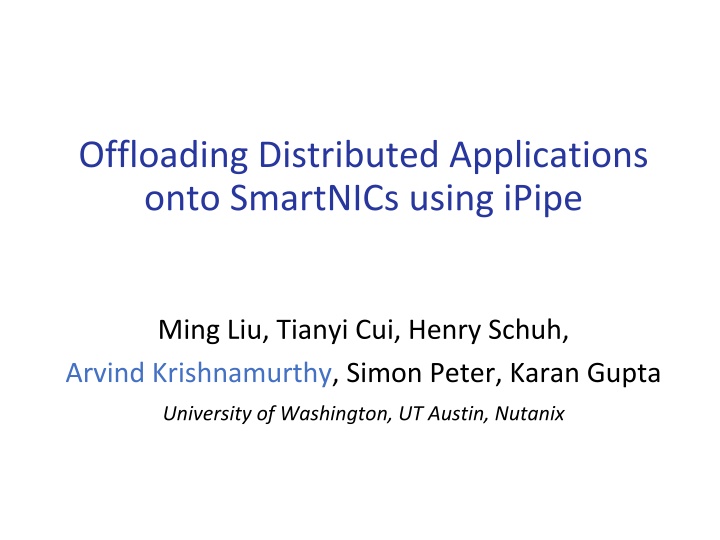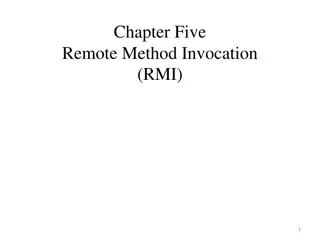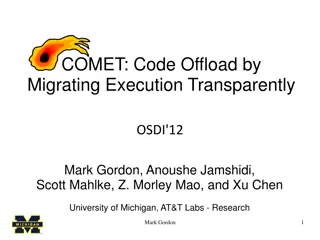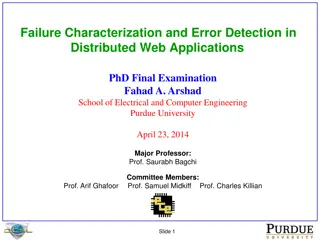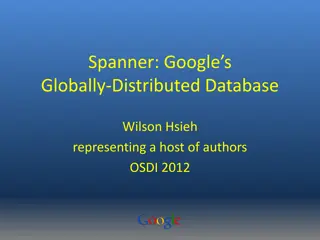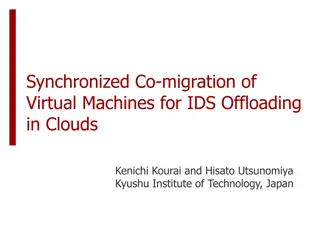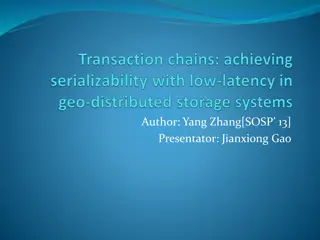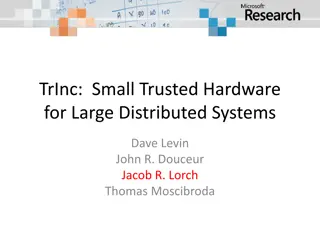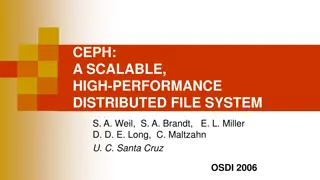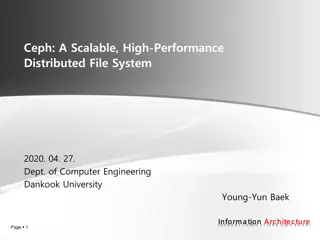SmartNIC Offloading for Distributed Applications
This presentation discusses offloading distributed applications onto SmartNICs using the iPipe framework. It explores the potential of programmable NICs to accelerate general distributed applications, characterizes multicore SmartNICs, and outlines the development and evaluation process. The study covers different types of SmartNICs, structural differences based on packet flow, and the functions of on-path SmartNICs.
Download Presentation

Please find below an Image/Link to download the presentation.
The content on the website is provided AS IS for your information and personal use only. It may not be sold, licensed, or shared on other websites without obtaining consent from the author.If you encounter any issues during the download, it is possible that the publisher has removed the file from their server.
You are allowed to download the files provided on this website for personal or commercial use, subject to the condition that they are used lawfully. All files are the property of their respective owners.
The content on the website is provided AS IS for your information and personal use only. It may not be sold, licensed, or shared on other websites without obtaining consent from the author.
E N D
Presentation Transcript
Offloading Distributed Applications onto SmartNICs using iPipe Ming Liu, Tianyi Cui, Henry Schuh, Arvind Krishnamurthy, Simon Peter, Karan Gupta University of Washington, UT Austin, Nutanix
Programmable NICs Renewed interest in NICs that allow for customized per-packet processing Many NICs equipped with multicores & accelerators E.g., Cavium LiquidIO, Broadcom Stingray, Mellanox BlueField Primarily used to accelerate networking & storage Supports offloading of fixed functions used in protocols Can we use programmable NICs to accelerate general distributed applications?
Talk Outline Characterization of multicore SmartNICs iPipe framework for offloading Application development and evaluation
SmartNICs Studied Vendor BW Processor Deployed SW LiquidIOII CN2350 Marvell 2X 10GbE 12 cnMIPS core, 1.2GHz Firmware LiquidIOII CN2360 Marvell 2X 25GbE 16 cnMIPS core, 1.5GHz Firmware BlueField 1M332A Mellanox 2X 25GbE 8 ARM A72 core, 0.8GHz Full OS Stingray PS225 Broadcom 2X 25GbE 8 ARM A72 core, 3.0GHz Full OS Low power processors with simple micro-architectures Varying level of systems support (firmware to Linux) Some support RDMA & DPDK interfaces
Structural Differences Classified into two types based on packet flow On-path SmartNICs Off-path SmartNICs
On-path SmartNICs NIC cores handle all traffic on both the send & receive paths SmartNIC Traffic manager TX/RX ports Host cores NIC cores
On-path SmartNICs: Receive path NIC cores handle all traffic on both the send & receive paths SmartNIC Traffic manager TX/RX ports Host cores NIC cores
On-path SmartNICs: Send path NIC cores handle all traffic on both the send & receive paths SmartNIC Traffic manager TX/RX ports Host cores NIC cores Tight integration of computing and communication
Off-path SmartNICs Programmable NIC switch enables targeted delivery Host cores SmartNIC NIC switch NIC cores TX/RX ports
Off-path SmartNICs: Receive path Programmable NIC switch enables targeted delivery Host cores SmartNIC NIC switch NIC cores TX/RX ports
Off-path SmartNICs: Receive path Programmable NIC switch enables targeted delivery Host cores SmartNIC NIC switch NIC cores TX/RX ports
Off-path SmartNICs: Send path Programmable NIC switch enables targeted delivery Host traffic does not consume NIC cores Communication support is less integrated Host cores SmartNIC NIC switch NIC cores TX/RX ports
Packet Processing Performance Forwarding without any additional processing LiquidIO CN2350 14 256B 1024B Bandwidth (Gbps) 12 10 8 6 4 2 0 1 2 3 4 5 6 7 8 9 10 11 12 Core (#) Quantifies the default forwarding tax of SmartNICs Dependent on packet size workload
Processing Headroom Forwarding throughput as we introduce additional per-packet processing Broadcom Stingray 35 256B 1024B 30 Bandwidth (Gbps) 25 20 15 10 5 0 0 0.125 0.25 Packet processing latency (us) 0.5 1 2 4 8 16 Headroom is workload dependent and only allows for the execution of tiny tasks
Compute Performance Evaluated standard network functions on the SmartNIC cores Execution affected by cores' simpler micro- architecture and processing speeds Suitable for running applications with low IPC Computations can leverage SmartNIC's accelerators but tie up NIC cores when batched E.g., checksums, tunneling, crypto, etc.
Packet Processing Accelerators On-path NICs provide packet processing accelerators Moving packets between cores and RX/TX ports Hardware-managed packet buffers with fast indexing LiquidIO CN2350 4 SmartNIC-send SmartNIC-recv DPDK-send DPDK-recv 3.5 3 Latency (us) 2.5 2 1.5 1 0.5 0 4 8 16 32 Packet size (B) 64 128 256 512 1024 Fast and packet-size independent messaging
Host Communication Traverse PCIe bus either through low-level DMA or higher-level RDMA/DPDK interfaces LiquidIO CN2350 2.5 1024B 2 Latency (us) 1.5 1 0.5 0 Blocking read Non-blocking read Blocking write Non-blocking write Non-trivial latency and overhead Useful to aggregate and perform scatter/gather
iPipe Framework Programming framework for distributed applications desiring SmartNIC offload Addresses the challenges identified by our experiments Host communication overheads distributed actors Variations in traffic workloads dynamic migration Variations in execution costs scheduler for tiny tasks
Actor Programming Model Application logic expressed using a set of actors Each actor has well-defined local object state and communicates with explicit messages Migratable actors; supports dynamic communication patterns
Actor Scheduler Goal is to maximize SmartNIC usage, and Prevent overloading and ensure line-rate communications Provide isolation and bound tail latency for actor tasks Theoretical basis: Shortest Job First (SJF) optimizes mean response time for arbitrary task distributions If the tail response time is to be optimized: First come first served (FCFS) is optimal for low variance tasks Processor sharing is optimal for high variance tasks
iPipes Hybrid Scheduler Design overview: Combine FCFS and deficit round robin (DRR) Use FCFS to serve tasks with low variance in service times DRR approximates PS in a non-preemptible setting Dynamically change actor location & service discipline Monitor bounds on aggregate mean and tail latencies Profile the mean and tail latency of actor invocations
FCFS Scheduling FCFS cores fetch incoming requests from a shared queue and perform run-to-completion execution Host cores Mean latency > Mean_ threshold Tail latency > Tail_threshold Actors NIC FCFS core NIC FCFS core NIC FCFS cores NIC DRR core NIC DRR core NIC DRR cores Shared queue
DRR Scheduling DRR cores traverse the runnable queue and execute actor when its deficit counter is sufficiently high Host cores Mailbox_len > Q_threshold Tail latency < (1- ) Tail_threshold Actors NIC FCFS core NIC FCFS core NIC FCFS cores NIC DRR core NIC DRR core NIC DRR cores Shared queue
Applications Built Using iPipe Replicated and consistent key-value store Real time analytics Transaction processing system
Replicated Key-Value Store Log-structured merge tree for durable storage SSTables stored on NVMe devices attached to host Replicated and made consistent using Paxos iPipe realization: Memtable/commit log is typically resident on SmartNIC Compaction operations on the host
Evaluation Application benefits: Core savings for a given throughput Or higher throughput for a given number of cores Latency & tail latency gains Also in the paper: iPipe overheads Comparison to Floem Network functions using iPipe Efficiency of actor scheduler
Host Core Savings for LiquidIO CN2360 Testbed: Supermicro servers, 12-core E5-2680 v3 Xeon CPUs DPDK-64B iPipe-64B DPDK-1KB iPipe-1KB 10 8 Core (#) 6 4 2 0 RTA Worker DT DT RKV Leader RKV Follower Coord. Participant Offloading adapts to traffic workload Average reduction in host core count is 73% for 1KB packets
RKV Store Latency/Throughput (LiquidIO CN2360) Fixed the host core count and evaluated the improvement in application throughput 120 DPDK iPipe 100 Latency (us) 80 60 40 20 0 0 0.5 1 Per-core Throughput (Mop/s) 1.5 2 2.5 3 3.5 4 2.2x higher throughput and 12.5us lower latency
Summary Performed an empirical characterization of SmartNICs Significant innovation in terms of hardware acceleration Off-path and on-path designs embody structural differences SmartNICs can be effective but require careful offloads IPipe framework enables offloads for distributed applications Actor-based model for explicit communication & migration Hybrid scheduler for maximizing SmartNIC utilization while bounding mean/tail actor execution costs Demonstrated offloading benefits for distributed applications
Hardware Packet Dispatch Low overhead centralized packet queue abstraction 60 1024B 50 Latency (us) 40 30 20 10 0 6core-avg 12core-avg 6core-p99 12core-p99
iPipe Overheads Examined non-actor implementation with iPipe version For the RKV application, iPipe introduces about 10% overhead at different network loads 400 Leader w/o iPipe Follower w/o iPipe Leader w/ iPipe Follower w/ iPipe CPU usage (%) 300 200 100 0 10 30 50 70 90 Network Load (%)
